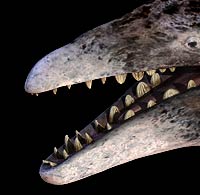Dorudon, was the contemporary Cetacean of the more massive and deadly Basilosaurus, another primitive toothed whale. Dorudon, means, 'Spear-Toothed'. It was essentially a smaller and more compact, scaled down version of Basilosaurus, with subtle yet important differences to mark it out as its own species. Indeed, Dorudon was, upon discovery in the same region (Valley of the Whales in Egypt) as was Basilosaurus discovered first, initially thought to be the sought after juvenile Basilosaurus specimen (the true Basilosaurus has never been found in the form of a juvenile, frustrating Palaeontologists in this field, with only the adults to show)
However, after greater analysis, it became clear that these animals were different - as soon baby Dorudon were found, which were far too small, even as babies, to be infants of the massive Basilosaurus. Nevertheless, these were still fairly huge animals, approaching the same size as Orcas (Killer Whales) at 5-6 Metres Long and perhaps several tonnes, though they were nothing like as bulky and imposing as Orcas. In comparison with the 16-18 Metre Long Basilosaurus though, they were small, and potential prey items. In pods, they could resist the doubtlessly solitary
Basilosaurus predators, though as portrayed in Walking With Beasts, a hungry Basilosaurus could be very successful in hunting babies by separating them from their mothers. This is not entirely creative or merely dramatic speculation; baby Dorudon skeletons have been found with horrific injuries, sustained when the unfortunate animals were indeed alive. Although it is not known for certain whether Basilosaurus was the killer culprit, it is almost bound to only have been them in a way - for its time, few (if any) marine carnivores could have caused the death of a baby Dorudon, which would have once been protected by a mother. It seems certain to many experts that the only thing that could separate a baby Dorudon from a violently protective mother, would be a terrifying fully grown Basilosaurus on the hunt.
Although no bitemarks are to be found on the bones of baby Dorudon in the shallow bay (which Geologists know it was during the Late Eocene, though it is part of the Sahara Desert now) in which these infants were killed, their skulls have literally been crushed by some unknown force - their heads brutally smashed in. The only predator around capable of such, seems to be Basilosaurus. Dorudon would have travelled in pods, perhaps calving in secluded lagoons and bays, with the mothers protecting the infants as best they could. Apparently, at least sometimes, they could not defend their offspring well enough. Their diet consisted of small fish, small molluscs and small crustaceans. Though first found in Egypt, especially in the famed Fayum Deposits as also was Basilosaurus, Dorudon - as with its enemy the Basilosaurus - would also be found in North America later on. North America and Africa, had important coastlines on the Tethys Ocean, that continued to close well into the rest of the Tertiary/Palaeogene Period as a whole. It was in these tropical and arcane, Mesozoic Era veteran waters that later Cenozoic Era animals such as Dorudon and Basilosaurus would live. When the legendary Tethys closed, the end of a great 200 million year (and more) beauty was marked; having great consequences for life.
Description[]
Dorudon has a long, narrow snout, and almost certainly lacked the bulbous 'melon' that forms the spherical bulge on the facial profile of modern toothed whales.





